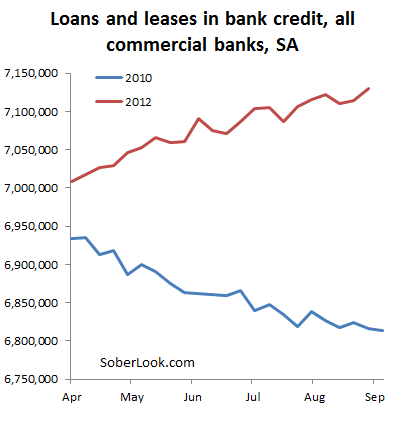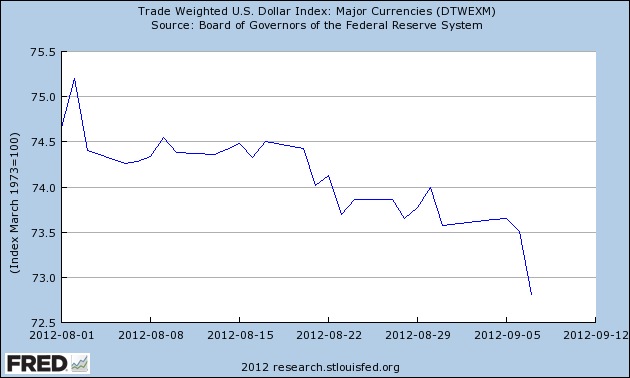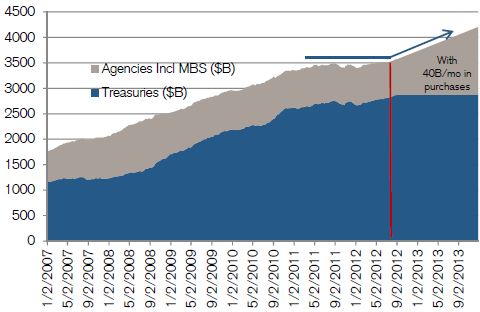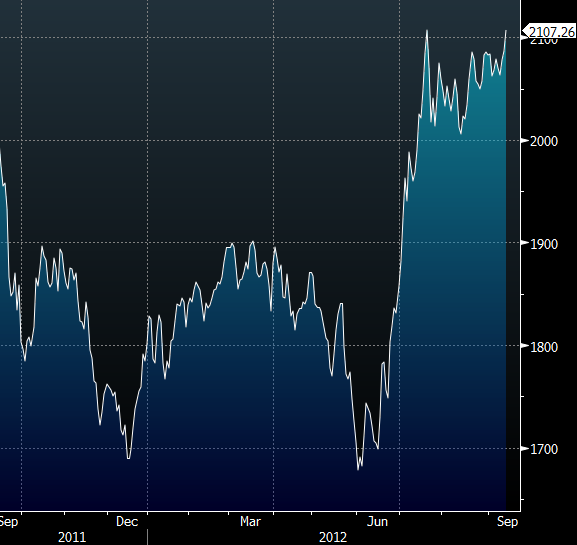QE3 into infinity and stagflation – Federal Reserve now purchasing over 50 percent of MBS and planning on buying $40 billion per month into infinity.
- 0 Comments
The Federal Reserve is playing with financial fire here. The last employment report was terribly weak and no amount of spinning can make it good. The drop was largely based on hundreds of thousands of Americans dropping out of the labor force. Is that really a positive sign? Last week we received data from the Census Bureau showing US household median income is now back to levels last seen in 1995. The Fed responded with an open ended invitation to inflation via Quantitative Easing III. Yet there is an inherent risk that is now approaching with stagflation. With GDP growth tepid and employment weak, any rise in inflation will likely stifle consumer demand in the current economy. How much lower can the Fed really push interest rates by purchasing mortgage backed securities? We are already at negative interest rates. Yet the Federal Reserve only understands this monetary policy measure and is beholden to the financial sector. These same policies have been in play since 2007 and who is really coming out ahead?
Throwing more fuel into the fire
The need for QE3 is suspect. Banks are already lending again so the telegraphing of QE3 is a sign that banks should lend more but to whom?
Source:Â FRB
The Fed will now purchase over 50 percent of all MBS in the current market. That is completely unhealthy and sets the stage for continued expansion to their nearly $3 trillion portfolio. There is nothing novel or unique of the current policy initiative. It is more of the same. What we have gotten is declining household income but also the highest poverty rates in a generation. Inflation on the surface has been muted since a big portion of the CPI is made up of the “owner’s equivalent of rent†component which by the way, missed the entire housing bubble. Yet thanks to the current free flowing money, this item is now increasing and even with the massaged CPI inflation is rearing its head at the same time that incomes have fallen. The taste of stagflation is rearing its head. Stagflation can also be felt in the sense of a declining standard of living.
To give you a perspective of a country deeply in stagflation just look at Argentina:
Stagflation extreme example – Argentina
-Zero growth
-Poor domestic demand
-Weakening currency
-25 percent inflation rate
For the US, growth is already weak and the currency is taking a hit since the Fed is doing all it can to slam the dollar lower. How has the dollar performed with the Fed telegraphing QE3?
Keep in mind this is occurring while the crisis in Europe is still unfolding. This should tell you what markets are thinking about QE3. Going back to the stagflation case, the risk that we now run with this kind of aggressive monetary policy is that inflation creeps into markets with no noticeable jump in demand. The US household is at a defining crossroads. Simply promising that you will buy up mortgage backed securities into infinity until the unemployment rate falls dramatically is deceptive and financially risky. At this stage with mortgage rates near 3.5 percent it is questionable how much lower rates can go with QE3. Rates are already in a negative position so anything lower is unlikely to make US consumers go out and buy more houses or arouse the construction market especially when banks have plenty of inventory to leak out for years to come. Plus, you have many baby boomers looking to downsize.
Keep expanding that MBS folder
The Fed just keeps on expanding their debt folder:
We might as well bring in the GSEs into the Fed’s portfolio and allow them to originate mortgages. They are the market. Yet to what end goal are we going here? The Fed talks about fixing the employment market and their end result is buying up MBS from member banks? Really? The Fed is a one trick pony in this regard. It was Alan Greenspan and the aggressive push to lower rates that set the fuel for the housing bubble. It was also the Fed that turned a blind eye to Wall Street when every toxic mortgage was being made when evidence was flashing red for years that a bubble was ongoing. Now, the solution to all of this is QE part three where the Fed buys up practically every MBS on the market. The rest are sucked into the GSEs that have a mandate to lower their portfolios. The only winners in the end here are the banks that are crossing their fingers to offload inflated assets they have on their books that are legacy items from the grand housing bubble.
The unseen consequences
Nothing happens in a vacuum of course. These kind of actions are essentially off-shoring inflation to global markets. Take a look at agricultural commodities:
Source:Â Diapason Commodities Index Agriculture Price Index
Keep in mind that many economies around the world are very sensitive to food prices since food takes up a larger portion of a family’s budget. So with rising costs hitting you are seeing more global turmoil. With the US drought and the Fed basically telegraphing more inflation to global markets expect more volatility to occur. Why should we even expect a different result from more quantitative easing? This is basically more of a ploy to help the financial sector at the expense of the American working and middle class.
If you enjoyed this post click here to subscribe to a complete feed and stay up to date with today’s challenging market!



 If you enjoyed this post click here to subscribe to a complete feed and stay up to date with today’s challenging market!
If you enjoyed this post click here to subscribe to a complete feed and stay up to date with today’s challenging market!